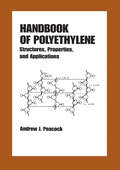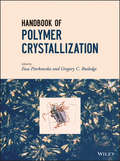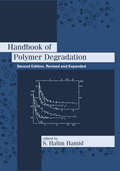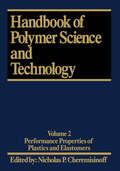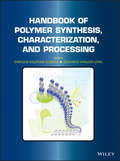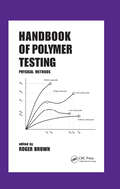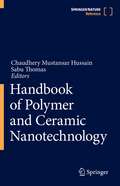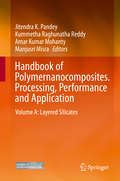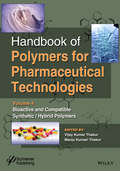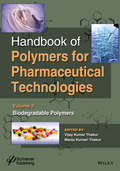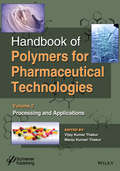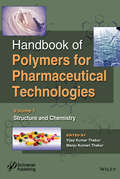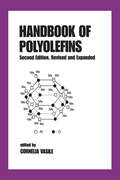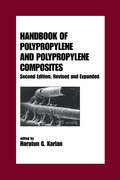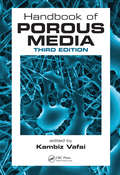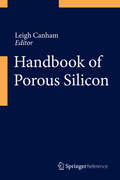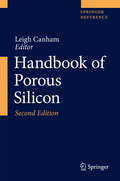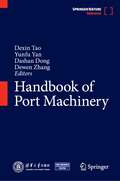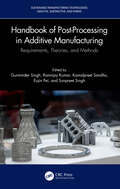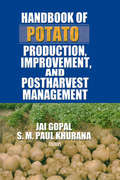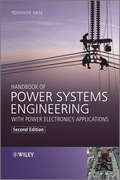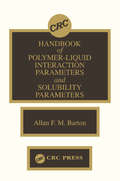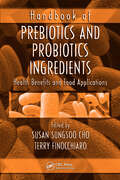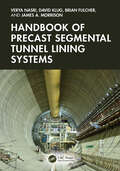- Table View
- List View
Handbook of Polyethylene: Structures: Properties, and Applications (Plastics Engineering)
by Andrew PeacockThis text provides the basic history, molecular structure and intrinsic properties, practical applications and future developments of polyethylene production and marketing - including recycling systems and metallocene technology. It describes commercial processing techniques used to convert raw polyethylene to finished products, emphasizing special
Handbook of Polymer Crystallization
by Ewa Piorkowska Gregory C. RutledgePolymeric crystals are more complex in nature than other materials' crystal structures due to significant structural disorder present. The only comprehensive reference on polymer crystallization, Handbook of Polymer Crystallization provides readers with a broad, in-depth guide on the subject, covering the numerous problems encountered during crystallization as well as solutions to resolve those problems to achieve the desired result. Edited by leading authorities in the field, topics explored include neat polymers, heterogeneous systems, polymer blends, polymer composites orientation induced crystallization, crystallization in nanocomposites, and crystallization in complex thermal processing conditions.
Handbook of Polymer Degradation
by S. Halim HamidCovers recent advances in polymer degradation and stabilization. Focuses on the basics of photo- and bio-degradability. Delineates special and general environmental parameters such as solar irradiation, temperature, and agrochemical exposure. Surveys plastic waste disposal strategies such as recycling, incineration, chemical recovery by pyrolysis, and source reduction.
Handbook of Polymer Science and Technology
by 0 Cheremisinoff,This handbook focuses on physical, structural, and compositional properties of elastomeric materials and plastics. It provides a broad overview of the physical and physicochemical properties of synthetic rubbers that are used in conventional cured applications.
Handbook of Polymer Synthesis, Characterization, and Processing
by Eduardo Vivaldo-Lima Enrique Saldivar-GuerraCovering a broad range of polymer science topics, Handbook of Polymer Synthesis, Characterization, and Processing provides polymer industry professionals and researchers in polymer science and technology with a single, comprehensive handbook summarizing all aspects involved in the polymer production chain. The handbook focuses on industrially important polymers, analytical techniques, and formulation methods, with chapters covering step-growth, radical, and co-polymerization, crosslinking and grafting, reaction engineering, advanced technology applications, including conjugated, dendritic, and nanomaterial polymers and emulsions, and characterization methods, including spectroscopy, light scattering, and microscopy.
Handbook of Polymer Synthesis: Second Edition (Plastics Engineering)
by Graham Swift Hans R. Kricheldorf Oskar NuykenAn in-depth review of important preparative methods for the synthesis and chemical modification of polymers, this authoritative second edition examines the advantages and limitations of various polymerization applications and procedures. It features new approaches and innovative strategies from the most prominent industry and academic laboratories,
Handbook of Polymer Testing: Physical Methods (Plastics Engineering)
by Roger BrownThe Handbook of Polymer Testing: Physical Methods provides virtually currently used techniques for measuring and testing the physical properties of polymers. A concise but detailed technical guide to the physical testing methods of synthetic polymers in plastics, rubbers, cellular materials, textiles, coated fabrics, and composites, the book analys
Handbook of Polymer and Ceramic Nanotechnology
by Sabu Thomas Chaudhery Mustansar HussainThis handbook examines the recent advances in the nanotechnology of polymers and ceramics, which possess outstanding mechanical properties and compatibility given their unique physical and chemical properties caused by the unusually large surface area to volume ratios and high interfacial reactivity. This handbook highlights the various compositions and morphologies of polymer and ceramic nanomaterials that can serve as powerful tools for the diverse applications in areas such as electronics, photonics, shape-memory alloys, biomaterials and biomedical nanomaterials, graphene-based technologies, and textiles and packaging. The handbook addresses safety, economics, green production and sustainability. The book contains a section on functionalization of these molecules, which only increases the possibility of developing even more versatile materials that can be fine-tuned for specific applications. Filling a gap in the literature, this handbook provides comprehensive coverage of properties, fabrication, characterization, functionalization methods and applications at both experimental and theoretical models scales. Economic, toxicological, regulatory, and environmental concerns regarding applications are also discussed in detail. Special attention is paid to sustainable approaches that reduce costs in terms of chemicals and time consumption. The book covers research trends, challenges, and prospective topics as well.
Handbook of Polymernanocomposites. Processing, Performance and Application
by Jitendra K. Pandey Kummetha Raghunatha Reddy Amar Kumar Mohanty Manjusri MisraVolume A of Handbook of Polymer Nanocomposites deals with Layered Silicates. In some 20 chapters the preparation, architecture, characterisation, properties and application of polymer nanocomposites are discussed by experts in their respective fields
Handbook of Polymers for Pharmaceutical Technologies, Bioactive and Compatible Synthetic/Hybrid Polymers
by Vijay Kumar Thakur Manju Kumari ThakurPolymers are one of the most fascinating materials of the present era finding their applications in almost every aspects of life. Polymers are either directly available in nature or are chemically synthesized and used depending upon the targeted applications. Advances in polymer science and the introduction of new polymers have resulted in the significant development of polymers with unique properties. Different kinds of polymers have been and will be one of the key in several applications in many of the advanced pharmaceutical research being carried out over the globe. This 4-part set of books contains precisely referenced chapters, emphasizing different kinds of polymers with basic fundamentals and practicality for application in diverse pharmaceutical technologies. The volumes aim at explaining basics of polymers based materials from different resources and their chemistry along with practical applications which present a future direction in the pharmaceutical industry. Each volume offer deep insight into the subject being treated. Volume 1: Structure and Chemistry Volume 2: Processing and Applications Volume 3: Biodegradable Polymers Volume 4: Bioactive and Compatible Synthetic/Hybrid Polymers
Handbook of Polymers for Pharmaceutical Technologies, Biodegradable Polymers
by Vijay Kumar Thakur Manju Kumari ThakurPolymers are one of the most fascinating materials of the present era finding their applications in almost every aspects of life. Polymers are either directly available in nature or are chemically synthesized and used depending upon the targeted applications. Advances in polymer science and the introduction of new polymers have resulted in the significant development of polymers with unique properties. Different kinds of polymers have been and will be one of the key in several applications in many of the advanced pharmaceutical research being carried out over the globe. This 4-part set of books contains precisely referenced chapters, emphasizing different kinds of polymers with basic fundamentals and practicality for application in diverse pharmaceutical technologies. The volumes aim at explaining basics of polymers based materials from different resources and their chemistry along with practical applications which present a future direction in the pharmaceutical industry. Each volume offer deep insight into the subject being treated. Volume 1: Structure and Chemistry Volume 2: Processing and Applications Volume 3: Biodegradable Polymers Volume 4: Bioactive and Compatible Synthetic/Hybrid Polymers
Handbook of Polymers for Pharmaceutical Technologies, Processing and Applications
by Vijay Kumar Thakur Manju Kumari ThakurPolymers are one of the most fascinating materials of the present era finding their applications in almost every aspects of life. Polymers are either directly available in nature or are chemically synthesized and used depending upon the targeted applications. Advances in polymer science and the introduction of new polymers have resulted in the significant development of polymers with unique properties. Different kinds of polymers have been and will be one of the key in several applications in many of the advanced pharmaceutical research being carried out over the globe. This 4-partset of books contains precisely referenced chapters, emphasizing different kinds of polymers with basic fundamentals and practicality for application in diverse pharmaceutical technologies. The volumes aim at explaining basics of polymers based materials from different resources and their chemistry along with practical applications which present a future direction in the pharmaceutical industry. Each volume offer deep insight into the subject being treated. Volume 1: Structure and Chemistry Volume 2: Processing and Applications Volume 3: Biodegradable Polymers Volume 4: Bioactive and Compatible Synthetic/Hybrid Polymers
Handbook of Polymers for Pharmaceutical Technologies, Structure and Chemistry
by Vijay Kumar Thakur Manju Kumari ThakurPolymers are one of the most fascinating materials of the present era finding their applications in almost every aspects of life. Polymers are either directly available in nature or are chemically synthesized and used depending upon the targeted applications. Advances in polymer science and the introduction of new polymers have resulted in the significant development of polymers with unique properties. Different kinds of polymers have been and will be one of the key in several applications in many of the advanced pharmaceutical research being carried out over the globe. This 4-partset of books contains precisely referenced chapters, emphasizing different kinds of polymers with basic fundamentals and practicality for application in diverse pharmaceutical technologies. The volumes aim at explaining basics of polymers based materials from different resources and their chemistry along with practical applications which present a future direction in the pharmaceutical industry. Each volume offer deep insight into the subject being treated. Volume 1: Structure and Chemistry Volume 2: Processing and Applications Volume 3: Biodegradable Polymers Volume 4: Bioactive and Compatible Synthetic/Hybrid Polymers
Handbook of Polyolefins (Plastics Engineering)
by Cornelia VasileA handbook on polyolefins. This second edition includes new material on the structure, morphology and properties of polyolefin (PO) synthesis. It focuses on synthetic advances, the use of additives, special coverage of PO blends, composites and fibres, and surface treatments. It also addresses the problem of interfacial and superficial phenomena.
Handbook of Polypropylene and Polypropylene Composites, Revised and Expanded
by Harutun G. KarianBuilding on the success of its predecessor with completely revised material and six new chapters, the Handbook of Polypropylene and Polypropylene Composites, Second Edition responds to increasing interest and changing global trends in the manufacture and application of polypropylene resin. The authors highlight viable options for the manufacture of
Handbook of Porous Media
by Kambiz VafaiHandbook of Porous Media, Third Edition offers a comprehensive overview of the latest theories on flow, transport, and heat-exchange processes in porous media. It also details sophisticated porous media models which can be used to improve the accuracy of modeling in a variety of practical applications. Featuring contributions from leading experts i
Handbook of Porous Silicon
by Leigh CanhamThe Handbook of Porous Silicon brings together the expertise of a large, international team of almost 100 academic researchers, engineers and product developers from industry across electronics, medicine, nutrition and consumer care to summarize the field in its entirety with 150 chapters and 5000 references. The volume presents 5 parts which cover fabrication techniques, material properties, characterization techniques, processing and applications. Much attention was given in the past to its luminescent properties, but increasingly it is the biodegradability, mechanical, thermal and sensing capabilities that are attracting attention. The volume is divided into focussed data reviews with, wherever possible, quantitative rather than qualitative descriptions of both properties and performance. The book is targeted at undergraduates, postgraduates and experienced researchers
Handbook of Porous Silicon
by Leigh CanhamThis handbook updates the most fast-moving research areas of porous silicon research, introduces a range of brand new topics not reviewed before and is even more inclusive of worldwide centres of expertise. Rapid advances are being made in porous silicon anodes for lithium batteries, biodegradable nanoparticles and nanoneedles for medical therapy and imaging, energetics and bio-diagnostic techniques. A number of additional characterization and processing techniques are also reviewed for the first time. Experts from 10 additional countries are involved in the 2nd edition: China, Vietnam, Singapore, Malaysia, Saudi Arabia, Turkey, Netherlands, Switzerland, Belarus, and Brazil, making more than 40 countries in total. The handbook therefore covers expertise from every continent. Another new feature is a review dedicated to industrial activity. This second edition endeavours to provide the community with a truly comprehensive database and up-to-date commentary on this versatile nanostructured material.
Handbook of Port Machinery
by Dexin Tao Yunfu Yan Dashan Dong Dewen ZhangThe CCMS Handbook of Port Machinery is an extensive reference guide intended to meet the needs of port handling machinery users and port planning and design institutes with regard to equipment selection, equipment application, and maintenance management. It comprehensively and systematically introduces readers to the characteristics, classification, structure, working principles, main technical performance parameters, corresponding technical standards, and matters requiring special attention in equipment selection for typical port handling machinery. The handbook supplements relevant handbooks on port machinery product design specifications, and provides essential technical guidance to help users fully understand and correctly select port machinery and equipment. At the same time, it offers a valuable resource for technical personnel, university teachers and students who are engaged in port planning and design, handling process design, port machinery product design, portmachinery use and maintenance. A comprehensive guide to port handling machinery, it reflects the current state of development and application status of port machinery in China.
Handbook of Post-Processing in Additive Manufacturing: Requirements, Theories, and Methods (Sustainable Manufacturing Technologies)
by Eujin Pei Sunpreet Singh Kamalpreet Sandhu Ranvijay Kumar Gurminder SinghHandbook of Post-Processing in Additive Manufacturing is a key resource on postprocessing treatments available for additive manufactured products. It provides broad coverage of the theory behind emerging technology, material development, functional characterization, and technical details required to investigate novel applications and methods and put them to use. The handbook presents experimental breakthroughs of novel methodologies that treat additively manufactured parts, which are suitable for demanding engineering applications. This handbook emphasizes the various types of post-processing technologies that can effectively eliminate the inferiorities of additively manufactured components. It also provides a collection of key principles, literature, methodologies, experimental results, case studies, and theoretical aspects of the different types of postprocessing techniques, along with different classes of materials and end-applications. This book is an ideal reference for libraries and post-graduate courses as well as the professional market, including, but not limited to manufacturing, mechanical and industrial engineering, and materials science.
Handbook of Potato Production, Improvement, and Postharvest Management
by Jai Gopal S.M. KhuranaPotatoes are a crucial food crop around the world, grown in nearly 150 countries. The Handbook of Potato Production, Improvement, and Postharvest Management compiles everything you need to know about potato crop production in one well-organized reference. Leading international authorities clearly discuss the biology, genetics, breeding, diseases, and effective approaches for improvement of crop and handling after harvest. This one-of-a-kind text explores, from interdisciplinary perspectives, every aspect of potato crop management from seed germination to end use while presenting the most current research available.
Handbook of Power Systems Engineering with Power Electronics Applications
by Yoshihide HaseFormerly known as Handbook of Power System Engineering, this second edition provides rigorous revisions to the original treatment of systems analysis together with a substantial new four-chapter section on power electronics applications. Encompassing a whole range of equipment, phenomena, and analytical approaches, this handbook offers a complete overview of power systems and their power electronics applications, and presents a thorough examination of the fundamental principles, combining theories and technologies that are usually treated in separate specialised fields, in a single unified hierarchy.Key features of this new edition:Updates throughout the entire book with new material covering applications to current topics such as brushless generators, speed adjustable pumped storage hydro generation, wind generation, small-hydro generation, solar generation, DC-transmission, SVC, SVG (STATCOM), FACTS, active-filters, UPS and advanced railway traffic applicationsTheories of electrical phenomena ranging from DC and power frequency to lightning-/switching-surges, and insulation coordination now with reference to IEC Standards 2010New chapters presenting advanced theories and technologies of power electronics circuits and their control theories in combination with various characteristics of power systems as well as induction-generator/motor driving systemsPractical engineering technologies of generating plants, transmission lines, sub-stations, load systems and their combined network that includes schemes of high voltage primary circuits, power system control and protectionA comprehensive reference for those wishing to gain knowledge in every aspect of power system engineering, this book is suited to practising engineers in power electricity-related industries and graduate level power engineering students.
Handbook of Poylmer-Liquid Interaction Parameters and Solubility Parameters
by Allan F.M. BartonNow available for the first time, this valuable reference presents polymer solubility parameters and various polymer-liquid interaction parameters in an easy-to-use form. It critically evaluates and comprehensively compiles data from original sources. It presents these quantities polymer-by-polymer, alphabetically by polymer common chemical name, fully cross-referenced by systematic chemical names, alternative names and trade names. This one-of-a-kind handbook summarizes the relationship between the various quantities and their methods of determination. This resource is an absolute must for all who are interested in the chemical industry, specifically polymer chemistry, chemical engineering, applied chemistry, and physical chemistry.
Handbook of Prebiotics and Probiotics Ingredients: Health Benefits and Food Applications
by Susan Sungsoo Cho E. Terry FinocchiaroWhile there is little dispute that probiotics and prebiotics, alone and together, have been proven to promote gastrointestinal health and proper immune function, the challenge faced by researchers is finding not only the right combinations, but also finding those that are fully compatible with the formulation, processing, packaging, and distribution of functional foods. This volume comprehensively explores these variables and highlights the most current biological research and applications. It examines the sources of prebiotics and probiotics, describes the physiological functions of both products, and discusses promising applications for a plethora of disorders.
Handbook of Precast Segmental Tunnel Lining Systems
by Verya Nasri David Klug Brian Fulcher James A. MorrisonThis comprehensive handbook covers all aspects of design, production, and construction of precast concrete tunnel segmental lining, with the best practices in the field included in one book for the first time.New and current design methods and quantitative analyses are considered in line with ACI and ASTM codes, as well as a full selection of global standards for the reliable design of the product and all components. Also incorporated are new applications of science and technology, such as new admixtures, and the latest manufacturing processes and precisions, such as tight dimensional controls and high repeatability cycles.With detailed guidance from world-leading practitioners, this is the definitive international technical and practical manual on these linings, forming a one-stop reference for tunnel engineers and an invaluable resource for advanced students in civil, mechanical, and mining engineering.
